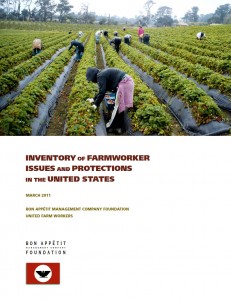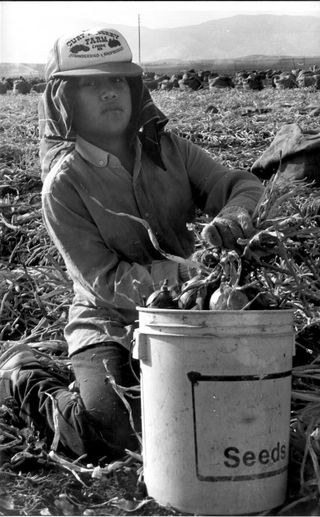Hungry for data: My thoughts on the Inventory of Farmworker Issues and Protections
- by Vera Chang
 A growing number of eaters now care where their food comes from, but it’s still uncommon for even conscientious consumers to also consider who planted, grew, picked, packed, and cleaned that food. Even most food industry professionals don’t look too deeply at this part of the food chain.
A growing number of eaters now care where their food comes from, but it’s still uncommon for even conscientious consumers to also consider who planted, grew, picked, packed, and cleaned that food. Even most food industry professionals don’t look too deeply at this part of the food chain.
Meanwhile, the conditions that farmworkers face in the everyday course of trying to do their jobs are grueling, often dangerous, and sometimes even abusive. It’s the age-old “if a tree falls in the forest” riddle: if these problems are invisible to most Americans, do they really exist?
The answer is yes, of course they do. And I am proud to have worked on a 65-page report about farmworker employment issues that documents them.
Released March 31, on César Chavez Day, the Inventory of Farmworker Issues and Protections in the United States is a joint effort of the United Farm Workers and Bon Appétit Management Company Foundation, with input from Oxfam America (a unique for-profit/non-profit partnership).
Bon Appétit came to this project believing that the first step to improving farm labor conditions and driving substantial, positive, long-lasting change is to know what’s happening. This is why Bon Appétit Vice President Maisie Greenawalt charged me and the other two Bon Appétit Foundation Fellows to work with UFW and Oxfam to figure out first what questions needed to be asked about farmworkers — and then how to answer them.
It has now been almost a year since we first set out to examine publicly available information on such matters as heat stress, pesticide exposure, and the involvement of children and youth in agriculture. Some of what we learned, we had expected to find. We guessed that our report would be similar to previous analyses that point to farmworkers’ few protections, the poor legal compliance and regulatory oversight of their work, and consequent multiplicity of issues. We also guessed that our report would confirm farmworker testimonies in that wages and conditions have barely budged over the last few decades, and, in many ways, are actually getting worse (see here).
 Farmworkers remain exempt from most federal wage and hour standards (including minimum wage on small farms, overtime pay, and mandatory breaks) and are subject to rampant wage theft and other abuses. And while farm labor is consistently ranked one of the most dangerous employment sectors, many farmworkers are ineligible for unemployment and workers’ compensation insurance. Children as young as 12 are legally allowed to work in the fields, and according to the National Agricultural Workers Survey in 2009, 4 percent of farmworkers began farm work at 12 years or younger, and more than 25 percent began farm work between 13 and 17.
Farmworkers remain exempt from most federal wage and hour standards (including minimum wage on small farms, overtime pay, and mandatory breaks) and are subject to rampant wage theft and other abuses. And while farm labor is consistently ranked one of the most dangerous employment sectors, many farmworkers are ineligible for unemployment and workers’ compensation insurance. Children as young as 12 are legally allowed to work in the fields, and according to the National Agricultural Workers Survey in 2009, 4 percent of farmworkers began farm work at 12 years or younger, and more than 25 percent began farm work between 13 and 17.
Even though we expected to find these sorts of results, they still make my lunchtime salad churn in my stomach.
However, what surprised me most about our research was all the data that was missing, and the inconsistencies in the data that we found. It turns out that publicly available information is not always easily accessible, nor necessarily accurate. For example, when investigating Farm Labor Contractors (FLCs), notorious for abusing farmworkers, I set out to find how many FLCs are operating in the U.S. as well as the extent of their violations. (Check out some of my thoughts on FLCs here.) As when investigating other topics in the Inventory, my list of null information seemed to grow exponentially compared with the rate of successful sources. I got accustomed to cycling among government agency representatives and elected officials before getting some sort of answer. At last I realized that I wasn’t being shunted aside, it’s just that information about agricultural workers is piecemeal and often hidden.
In the end, to get the official information on FLCs, I had to make an individual request under the Freedom of Information Act (FOIA). A response for these requests usually takes several weeks to months. But even once it arrives, many questions remain, as there is no guarantee of accuracy or the full picture. Estimates of how many farmworkers in California FLCs employ, for example, range from 18 to 75 percent. Not so helpful. According to the Department of Labor and my FOIA response, there were 5,354 FLCs total operating in the U.S. in 2009.
But still I wonder, how many FLCs are actually operating? And how many more FLCs are doing so off the books?
I could easily go on about the discrepancies in data and implications for workers. (For example, the farmworker fatality rate is five times the rate of the average worker in the U.S., but this may actually be a gross understatement, which Twilight Greenaway highlighted in her recent Civil Eats article.) But does it matter if the farmworker mortality rate is five times or ten times the rate of the average worker? In either case, it is shockingly and unacceptably high. The same for whether there are 300,000 or 800,000 children working in the fields. To me, the fact that at least one-fourth of farmworker families have incomes below the federal poverty line is enough of a reason to take action.
Now that the report has been released, I do have a sense of relief and satisfaction. But what’s happening in our fields is, stated simply, an injustice: much work is yet to be done. This unique and productive collaboration between the United Farm Workers and Bon Appétit challenges the way we have been doing things in the past. We have successfully kept farmworker problems out of sight, and therefore out of the public’s awareness.
In the end, it doesn’t matter whether we live close enough to have actually heard the tree fall in the forest. We owe it to the people who pick our food to address the inequity and unfairness that have been fueling our food system for far too long.
If you haven’t yet done so, I hope you’ll check out the Inventory, or at least the executive summary.
More coverage:
- New Farmworker Report Paints a Big, Grim Picture, Civil Eats
- Startling New Report Shines Light on Farm Labor Conditions—and They Ain’t Good, Grist
- Scott Shafer talks to Bon Appétit VP Maisie Greenawalt and others about farm labor conditions for KQED’s Forum